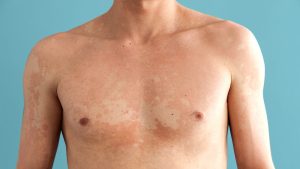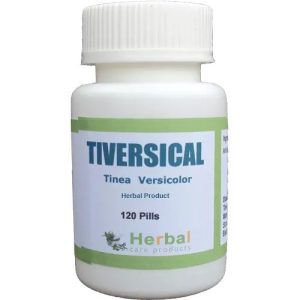No products in the cart.
Return To Shop 0 Cart $0.00 0
No products in the cart.
Return To Shop Shopping cart (0)
Subtotal: $0.00
Free shipping over 299$
How to Identify Tinea Versicolor: Signs, Symptoms, and Solutions
Tinea versicolor is a common skin infection caused by the overgrowth of a type of yeast that naturally resides on the skin. While not dangerous, this condition can cause noticeable skin changes that may affect a person’s confidence. Learning how to recognize tinea versicolor and understand the solutions available can help you manage it effectively.
What is Tinea Versicolor?
Tinea versicolor is a fungal infection that disrupts the skin’s pigmentation, leading to patches that are lighter or darker than your natural skin tone. The yeast that causes tinea versicolor, Malassezia, thrives in warm, humid environments, making it more common in hot and humid climates. Although the yeast is naturally present on everyone’s skin, an overgrowth can result in this distinctive skin condition.
Signs and Symptoms of Tinea Versicolor
Tinea versicolor primarily affects areas like the chest, back, neck, and upper arms. Here’s how to identify its most common signs and symptoms:
- Discolored Patches
The most prominent feature of tinea versicolor is the appearance of small patches of skin that differ in color from your usual skin tone. These patches may be lighter or darker and appear in various shades such as pink, tan, white, or brown. - Mild Itching
While not usually painful, tinea versicolor patches can sometimes be slightly itchy, particularly in humid or sweaty conditions. - Scaling or Dryness
In some cases, the affected areas may become dry or develop a mild, scaly texture. - No Tanning of Affected Areas
Tinea versicolor prevents affected areas from tanning normally. This can make the condition more noticeable, especially after sun exposure, as the surrounding skin darkens while the patches remain lighter.

Common Causes and Risk Factors
Though anyone can develop tinea versicolor, certain factors may increase susceptibility:
- Hot and Humid Climates
People living in tropical or subtropical climates are more prone to tinea versicolor due to the warm and moist conditions. - Oily Skin
Those with naturally oily skin may be more likely to experience overgrowth of Malassezia. - Weakened Immune System
Individuals with weakened immune systems may be at a higher risk of developing this condition. - Hormonal Changes
Adolescents, pregnant women, and others experiencing hormonal fluctuations are often more vulnerable to tinea versicolor.
Diagnosing Tinea Versicolor
If you suspect you have tinea versicolor, a dermatologist can typically diagnose it by examining the affected skin. In some cases, they may use a tool called a Wood’s lamp to illuminate the patches, which will appear yellow-green under the light. Skin scrapings are occasionally taken for closer examination under a microscope to confirm the diagnosis.
Related Articles: Is Tinea Versicolor the same as Eczema?
Solutions for Managing and Treating Tinea Versicolor
Although tinea versicolor is harmless, treatment is often sought to restore skin appearance and prevent further spread. Here are some effective solutions:
- Topical Antifungal Treatments
Over-the-counter (OTC) antifungal creams, lotions, or shampoos containing active ingredients like selenium sulfide, ketoconazole, or clotrimazole are typically effective in treating mild cases. Apply these treatments directly to the affected areas as directed. - Medicated Shampoos
For larger or persistent areas, a dermatologist may recommend using medicated antifungal shampoos containing ketoconazole or selenium sulfide on the affected skin. This approach is often convenient for widespread infections. - Oral Antifungal Medications
In cases where topical treatments are ineffective, doctors may prescribe oral antifungal medications like fluconazole or itraconazole. These medications are usually effective but must be taken as directed by a healthcare professional to prevent potential side effects. - Lifestyle and Home Remedies
While over-the-counter treatments and antifungal medications can be effective, some people prefer natural solutions to help keep the condition under control. Here are some tried-and-true natural remedies for managing tinea versicolor:
- Tea Tree Oil
Best Natural Tinea Versicolor Remedy for Tea tree oil is a potent antifungal and antimicrobial agent, making it a popular choice for skin infections.
- How to Use: Dilute a few drops of tea tree oil with a carrier oil, like coconut or olive oil. Apply to the affected areas with a cotton ball. Leave it on for 15-20 minutes, then rinse off.
- Why It Works: The antifungal properties of tea tree oil can help reduce the yeast on the skin, preventing the infection from spreading.
- Coconut Oil
Coconut oil is rich in medium-chain fatty acids, particularly lauric acid, known for its antifungal and anti-inflammatory benefits.
- How to Use: Apply a thin layer of virgin coconut oil to the patches. Leave it on for at least 30 minutes, or overnight for best results, before washing it off.
- Why It Works: Coconut oil helps moisturize the skin while controlling fungal growth, which can help reduce symptoms of tinea versicolor.
- Apple Cider Vinegar
Apple cider vinegar is acidic and contains natural antifungal properties that may help restore the skin’s pH balance.
- How to Use: Mix equal parts of apple cider vinegar and water. Apply to the affected area using a cotton ball and allow it to sit for 15 minutes before rinsing.
- Why It Works: Its acidic nature helps to kill yeast, balancing the skin’s pH and reducing the recurrence of tinea versicolor.
- Aloe Vera Gel
Aloe vera is known for its cooling and soothing properties and contains natural antifungal compounds.
- How to Use: Apply fresh aloe vera gel directly to the affected skin. Leave it on for 20-30 minutes before rinsing.
- Why It Works: Aloe vera soothes irritated skin and provides a protective layer that may help control fungal growth.
- Turmeric Paste
Turmeric has long been used in traditional medicine for its anti-inflammatory and antifungal properties.
- How to Use: Mix turmeric powder with a small amount of water or coconut oil to form a paste. Apply it to the patches and leave it on for 15-20 minutes before rinsing.
- Why It Works: The compound curcumin in turmeric can help reduce inflammation and inhibit the growth of fungi.
Related Articles: 5 Remedies for Tinea Versicolor You Can Do at Home
Supporting Lifestyle Practices
In addition to natural remedies, adopting certain lifestyle practices can help prevent tinea versicolor from recurring.
- Keep Skin Dry and Clean
Humidity and excess oil create an ideal environment for yeast to thrive. Shower after sweating and avoid wearing tight, non-breathable clothing. Using a gentle, pH-balanced cleanser can also help maintain the skin’s natural balance.
- Avoid Using Heavy Oils on the Skin
Although moisturizing is essential, avoid applying heavy, oily products to areas prone to tinea versicolor. Opt for non-comedogenic products that won’t clog pores.
- Consider Diet Adjustments
A diet high in sugar and refined carbs can contribute to yeast overgrowth. Focus on a balanced diet rich in vegetables, lean proteins, and whole grains, and consider incorporating foods with natural antifungal properties, such as garlic and coconut oil.
- Strengthen Immune Health
A strong immune system can help keep tinea versicolor under control. Regular exercise, adequate sleep, and a balanced diet are all crucial to immune function.
Preventing Recurrence of Tinea Versicolor
Although treatment can effectively clear up symptoms, tinea versicolor has a tendency to return, especially if the underlying conditions remain. Preventive steps can reduce the likelihood of recurrence:
- Use Medicated Cleansers Periodically
Regular use of antifungal or anti-yeast cleansers as part of your shower routine can help keep Malassezia under control. - Avoid Prolonged Sun Exposure
Since sun exposure can highlight skin discoloration, using a broad-spectrum sunscreen can help maintain an even skin tone and prevent the condition from becoming more visible. - Limit Excessive Sweating
Staying in a cool, dry environment as much as possible can prevent the yeast from thriving.
When to See a Dermatologist
While tinea versicolor is often manageable with OTC products, some cases may require professional care. If the patches are extensive, resistant to treatment, or causing significant discomfort, a dermatologist can offer stronger treatment options and advice tailored to your needs.
Final Thoughts
Tinea versicolor is a common, non-threatening skin condition that is easily identifiable through its unique discolored patches and mild symptoms. Recognizing these signs and knowing the appropriate solutions can help manage this condition effectively. Whether through simple lifestyle adjustments or medical treatments, there are multiple paths to clear, healthy skin.
More
More

